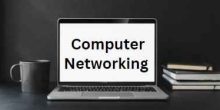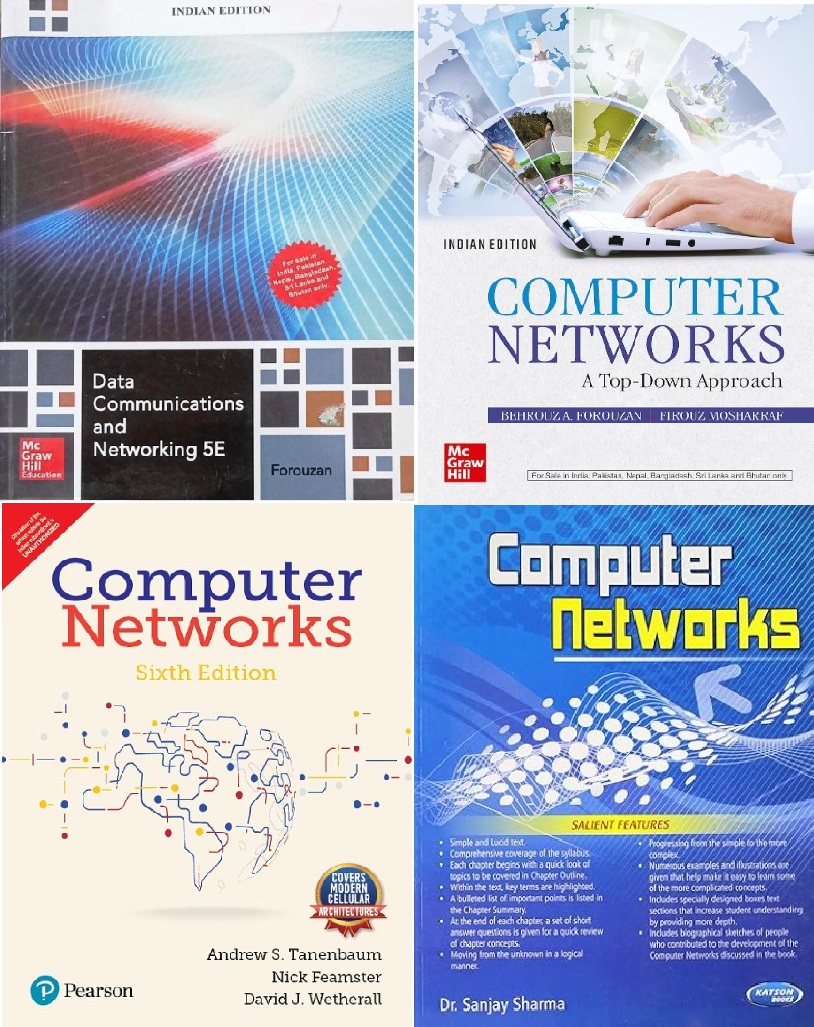UNIT 2: Physical Layer
Physical Layer: Transmission media, Signal transmission and encoding, Network performance and transmission impairments, Switching techniques and multiplexing, Overview of PSTN, ISDN, and ATM
Q41 – Which address is used on the internet for employing the TCP/IP protocols?
physical address and logical address
port address
specific address
all of the mentioned
Ans – (4)
Explanation – TCP/IP protocols use both physical addresses (like MAC addresses) and logical addresses (like IP addresses). Additionally, port addresses and specific address are also utilized for communication between specific applications
Q42 – The ________ layer is the layer closest to the transmission medium.
Physical
Data Link
Network
Transport
Ans – (1)
Explanation – The physical layer is the layer closest to the transmission medium. It is responsible for transmitting raw data bits over a communication channel and dealing with the physical characteristics of the transmission medium, such as voltage levels, cable types, and modulation techniques.
Q43 – The _________ measures the number of lost or garbled messages as a fraction of the total sent in the sampling period.
Residual Error rate
Transfer failure probability
Connection release failure probability
Connection establishment failure probability.
(Timothy Williams, McGraw Hill Education)
Ans – (1)
Explanation – The residual error rate quantifies the errors that remain after error correction techniques have been applied, providing a measure of the quality and reliability of the communication link.
Q44 – Which one of the following is not a client-server application?
Internet chat
Web browsing
E-mail
Ping
Ans – (4)
Explanation – Ping is a network utility used to test the reachability of a host on an Internet Protocol (IP) network. It works by sending ICMP (Internet Control Message Protocol) echo request packets to the target host and waiting for ICMP echo reply packets. It does not involve a client-server architecture; instead, it operates using a simple request-response model between two hosts. Therefore, Ping is not considered a client-server application.
The other options listed – Internet chat, Web browsing, and E-mail – are all examples of client-server applications, where clients (such as web browsers, chat clients, or email clients) interact with servers (web servers, chat servers, or mail servers) to request and receive data or services.
Q45 – The Quadrature Amplitude Modulation (QAM) has the same advantages as
ASK and FSK
ASK and PSK
FSK and PSK
None of the above
Ans – (2)
Explanation –
Quadrature Amplitude Modulation (QAM) combines both Amplitude Shift Keying (ASK) and Phase Shift Keying (PSK) to encode data. Therefore, it has the same advantages as both ASK and PSK.
QAM modulates both the amplitude and phase of the carrier signal. By combining these two modulation schemes, QAM can transmit more bits per symbol, increasing the data rate without requiring additional bandwidth.
Q46 – When Amplitude Shift Keying (ASK) is implemented using only two levels then it is called
Half Duplex ASK
Multilevel ASK
Binary ASK
Duplex ASK
Ans – (3)
Explanation –
Binary Amplitude Shift Keying (Binary ASK), also known as On-Off Keying (OOK), is a form of ASK where only two amplitude levels are used to represent binary data
One amplitude level (usually the presence of a carrier signal) represents a binary ‘1‘.
The other amplitude level (usually the absence of the carrier signal) represents a binary ‘0‘.
Q47 – Find the bandwidth for the AM if we need to modulate a 5-KHz voice
10 KHz
20 KHz
30 KHz
40 KHz
Ans – (1)
Explanation – Bandwidth = 2 × Frequency of the modulating signal = 2 x 5 = 10 KHz.
Q48 – The Quadrature means
below phase
above phase
in phase
out-of-phase
Ans – (4)
Explanation – The term “Quadrature” refers to a phase difference of 90 degrees (π/2 radians) between two signals. When two signals have a phase difference, they are “out-of-phase.“
Q49 – The most efficient and commonly used digital to analog conversion mechanism is
ASK
FSK
PSK
QAM
Ans – (4)
Explanation – The most efficient and commonly used digital-to-analog conversion mechanism is QAM (Quadrature Amplitude Modulation).
It Combines both amplitude and phase modulation, allowing it to transmit more bits per symbol. This makes QAM very efficient in terms of bandwidth and data rate. It’s widely used in modern communication systems, including Wi-Fi and cable modems, because of its efficiency and robustness.
Q50 – In Return to Zero (RZ), the signal changes not between bits but
before the bit
after the bit
doesn’t change
during the bit
Ans – (4)
Explanation – Return to Zero (RZ) is a type of signal encoding used in digital communications.
In RZ, the signal changes state during the bit period. This means that within each bit time, the signal will go to a specific level (often returning to zero volts) before the bit period ends.
Q51 – Line coding, block coding and scrambling are three techniques of
Digital to digital conversion
Digital to analog conversion
Analog to analog conversion
Analog to digital conversion
Ans – (1)
Explanation – Line coding, block coding, and scrambling are methods used in digital communication to improve the transmission of data. These techniques help in converting digital data into a format suitable for transmission over digital media. Option 1 is correct.
Q52 – Baud rate is the number of
signal elements per second
bits per second
Frames per second
None
Ans – (1)
Explanation – The baud rate is a measure of the number of signal changes or symbols that occur per second in a communication channel.
Q53 – _______ encoding has a transition at the middle of each bit.
RZ
Manchester
Differential Manchester
All the above
Ans – (4)
Explanation –
In RZ encoding, the signal returns to zero at the middle of each bit period. This helps in clock recovery and synchronization.
Manchester encoding ensures that there is a transition in the middle of each bit period. A ‘1’ bit is represented by a high-to-low transition, and a ‘0’ bit is represented by a low-to-high transition.
Differential Manchester encoding also guarantees a transition in the middle of each bit period. The presence or absence of a transition at the beginning of the period determines whether the bit is ‘0’ or ‘1’.
Q54 – The minimum bandwidth of Manchester and differential Manchester is
2 times that of NRZ
2 times that of NRZ-L
2 times that of NRZ-I
2 times that of RZ
Ans – (1)
Explanation – The minimum bandwidth of Manchester and differential Manchester encoding is 2 times that of NRZ (Non-Return to Zero).
Q55 – The term that refers to the shortest unit and carries data elements is called
Signal element
data carrier
Single element
both a and b
Ans – (1)
Explanation – A signal element is the shortest unit of a signal that can be used to represent data. It is the basic unit of information in a signal, used in digital communication to transmit data.
Each signal element can carry data elements such as bits. In different encoding schemes, the duration and pattern of these signal elements can vary, but they collectively represent the information being transmitted.
Q56 – Quadrature amplitude modulation is a combination of
BPSK and PSK
ASK and BPSK
ASK and PSK
BPSK and QPSK
Ans – (3)
Explanation – QAM is a modulation technique that combines both amplitude modulation and phase modulation to encode data. This allows QAM to transmit more bits per symbol compared to using only amplitude or phase modulation.
In ASK, the amplitude of the carrier signal is varied to represent binary data. Different amplitude levels are used to represent different symbols.
In PSK, the phase of the carrier signal is varied to represent binary data. Different phase shifts are used to represent different symbols.
Q57 – A signal with 200 mill watts power passes through 10 devices, each with an average noise of 2 microwatts, calculate SNR
5000
10000
150
200
Ans – (2)
Explanation – Total noise power = Noise power per device × Number of devices
Total noise power = 2 x 10-6 watts x 10
Signal to noise ratio (SNR) = Signal power / Noise power = 200 x 10-3 / 2 x 10-5 = 10000
So, the Signal-to-Noise Ratio (SNR) is 10,000.
Q58 – A signal in which 1 bit lasts 0.001 s, the Bit rate would be
1kbps
500bps
50bps
1700bps
Ans – (1)
Explanation – To calculate the bit rate, we use the formula
Bit rate = 1 / bit duration
Given that the duration of 1 bit is 0.001 seconds
Bit rate = 1 / 0.001
Bit rate = 1000 bps = 1 kbps.
Q59 – How many bits can fit on a link with a 2 ms delay if the bandwidth of the link is 10Mbps
200 bits
20,000 bits
200,000 bits
None of the Above
Ans – (2)
Explanation – Bandwidth = 10 Mbps
Delay = 2 ms
First, we need to convert the delay from milliseconds to seconds = 2 * 10-3 s
Now, we can calculate the number of bits
Number of bits = 10*106*2*10-3 = 20000 bits
Q60 – Modulation in which the two binary values are represented by two different amplitudes of the carrier frequency is known as
Aloha
Amplitude
Amplitude modulation
Amplitude-shift keying
Ans – (4)
Explanation – Amplitude-shift keying (ASK) is a modulation technique where digital data is conveyed through variations in the amplitude of a carrier wave.
One amplitude represents one binary state (like 0 or 1),
Another amplitude represents the other binary state.



